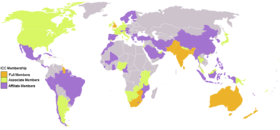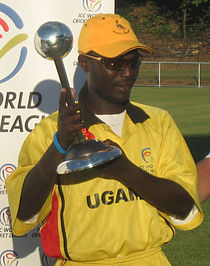- ICC ODI Championship
-
ICC ODI Championship 
ICC ODI Championship logoAdministrator International Cricket Council Format One Day International First tournament 2002 Last tournament ongoing Tournament format national (ongoing points
accumulation through
all matches played)Number of teams 13
29 Associate membersCurrent champion  Australia (130 points)
Australia (130 points)Most successful  Australia (97 months)
Australia (97 months)The ICC ODI Championship is an international One Day International cricket competition run by the International Cricket Council. The competition is notional in that it is simply a ranking scheme overlaid on the regular ODI match schedule. After every ODI match, the two teams involved receive points based on a mathematical formula. The total of each team's points total is divided by the total number of matches to give a rating, and all teams are ranked on a table in order of rating.
By analogy to cricket batting averages, the points for winning an ODI match are always greater than the team's rating, increasing the rating, and the points for losing an ODI match are always less than the rating, reducing the rating. A drawn match between higher and lower rated teams will benefits the lower-rated team at the expense of the higher-rated team. An "average" team that wins as often as it loses while playing a mix of stronger and weaker teams should have a rating of 100.
As of 11 September 2011, Australia lead the ICC ODI Championship with a rating of 130, while the lowest rated team, Kenya, has a rating of 0.
Contents
Qualification
The championship consists of two separate ranking tables. The ten ICC Full Members that play Test cricket are automatically listed on the main table. The six Associate Members with One Day International status are listed on a secondary table, but are eligible for promotion to the main table by meeting one of the following criteria:[1]
- two wins in ODIs against Full Members
- one win in an ODI against a Full Member and also have won more than 60% of qualifying matches versus other Associates
Ireland qualified for the main table following their victories over Pakistan and Bangladesh in the 2007 World Cup,[2]. and the Netherlands qualified in 2010 by beating Bangladesh. Kenya are also listed on the main table as they previously had permanent ODI status.
Points
The calculations for the Table are performed as follows:
- Each team scores points based on the results of their matches.
- Each team's rating is equal to its total points scored divided by the total matches played. (Series are not significant in these calculations).
- A match only counts if played in the last three years.
- Matches played in the first year of the three-year limit count one-third; matches played in the second year count two-thirds; matches played in the last year count fully; essentially, recent matches are given higher weighting.
- To determine a team's rating after a particular match:
- Determine the match result (win, loss, or tie)
- Calculate the match points scored:
- If the gap between the ratings of the two teams at the commencement of the match is fewer than 40 points, then:
- The winner scores 50 points more than the opponent's rating
- The loser scores 50 points fewer than the opponent's rating
- Each team in a tie scores the opponent's rating
- If the gap between the ratings of the two teams at the commencement of the match is more than or equal to 40 points, then :
- The winner, if it is the stronger team, scores 10 points more than its own rating
- The winner, if it is the weaker team, scores 90 points more than its own rating
- The loser, if it is the stronger team, scores 90 points fewer than its own rating
- The loser, if it is the weaker team, scores 10 points fewer than its own rating
- The stronger team in a tie scores 40 points fewer than its own rating
- The weaker team in a tie scores 40 points more than its own rating
- If the gap between the ratings of the two teams at the commencement of the match is fewer than 40 points, then:
- Add the match points scored to the points already scored (in previous matches as reflected by the Table) and determine the new rating. However, matches(and the points) which do not lie in last three year range will have to be removed.
- Points earned by teams depend on the opponents ratings, therefore this system needed to assign base ratings to teams when it started.
Ranking table
Rank Team Matches Points Rating 1  Australia
Australia32 4,124 129 2  Sri Lanka
Sri Lanka28 3,327 119 3  India
India39 4,603 118 4  South Africa
South Africa21 2,458 117 5  England
England35 3,706 106 6  Pakistan
Pakistan29 2,931 101 7  New Zealand
New Zealand25 2,174 87 8  West Indies
West Indies22 1,711 78 9  Bangladesh
Bangladesh29 1,836 63 10  Zimbabwe
Zimbabwe30 1,402 47 11  Ireland
Ireland12 492 41 12  Netherlands
Netherlands9 137 15 13  Kenya
Kenya7 0 0 Reference: ICC Rankings, 25 October 2011 Associate rankings
In late 2005, the International Cricket Council ranked the top non-Test nations from 11-30 to complement the Test nations' rankings in the ICC ODI Championship. The ICC used the results from the 2005 ICC Trophy and WCQS Division 2 competition (i.e. the primary qualification mechanisms for the 2007 Cricket World Cup) to rank the nations.
These rankings were used to seed the initial stage of the global World Cricket League. Teams ranked 11-16 were placed into Division 1; teams 17-20 were placed into Division 2; teams 21-24 were placed into Division 3; the remaining teams were placed into the upper divisions of their respective regional qualifiers.
As of 19 April 2009 the top six associates/affiliates gained one day status. Kenya and Ireland have both qualified to appear on the main rating table, Kenya from its existing status and Ireland for its two victories in the 2007 World Cup. Following their victory over Bangladesh in July 2010, the Netherlands joined the main table. Afghanistan, Canada and Scotland remain on the secondary table. In May 2009, the ICC added a rankings table for all associate and affiliate members. This contained both global and regional placings.
Associate rankings as at 14 October 2009 according to ICC:[3]
Rank Nation Regional Rank 14  Afghanistan
AfghanistanAsia No. 1 Associate/Affiliate member 15  Scotland
ScotlandEurope 3 16  Canada
CanadaAmericas No.1 Associate/Affiliate member 17  United Arab Emirates
United Arab EmiratesAsia 2 18  Namibia
NamibiaAfrica 2 19  United States
United StatesAmericas 2 20  Uganda
UgandaAfrica 3 21  Oman
OmanAsia 3 22  Denmark
DenmarkEurope 4 23  Papua New Guinea
Papua New GuineaEast Asia - Pacific No.1 Associate/Affiliate member 24  Hong Kong
Hong KongAsia 4 25  Bermuda
BermudaAmericas 3 26  Cayman Islands
Cayman IslandsAmericas 4 27  Italy
ItalyEurope 5 28  Tanzania
TanzaniaAfrica 4 29  Fiji
FijiEAP 2 30  Jersey
JerseyEurope 6 31  Nepal
NepalAsia 5 32  Argentina
ArgentinaAmericas 5 33  Singapore
SingaporeAsia 6 34  Bahrain
BahrainAsia 7 35  Guernsey
GuernseyEurope 7 36  Malaysia
MalaysiaAsia 8 37  Botswana
BotswanaAfrica 5 38  Norway
NorwayEurope 8 39  Nigeria
NigeriaAfrica 6 40  Japan
JapanEAP 3 41  Suriname
SurinameAmericas 6 42  Gibraltar
GibraltarEurope 9 Historical ICC ODI Champions
The ICC provides ratings for the end of each month back to October 2002. This table lists the teams that have successively held the highest rating since that date, by whole month periods.
Team Start End Total Months Cumulative Months Highest Rating  Australia
AustraliaOctober 2002 January 2007 52 52 140  South Africa
South AfricaFebruary 2007 February 2007 1 1 128  Australia
AustraliaMarch 2007 February 2008 12 64 130  South Africa
South AfricaMarch 2008 May 2008 3 4 127  Australia
AustraliaJune 2008 December 2008 7 71 131  South Africa
South AfricaJanuary 2009 August 2009 8 12 127  Australia
AustraliaSeptember 2009 present 26 97 134 Reference: ICC Rankings See also
- ICC Test Championship
- ICC T20 Championship
- International structure of cricket
- ICC Player Rankings
References
- ^ ICC - Associate and Affiliate Rankings
- ^ [1]
- ^ "ICC World Cricket League Rankings". ICC. http://icc-cricket.yahoo.net/rankings/icc-global-rankings.html. Retrieved 2009-05-18.[dead link]
External links
International cricket ICC · World Cup · Champions Trophy · World Twenty20 · Test Championship · ODI Championship · U-19 World Cup · Women's World Cup · Intercontinental Cup · World Cricket League · Awards
Test cricket · One Day International · Twenty20 InternationalAsia 
Africa Americas East Asia and Pacific EAP – ICC EAP Cricket Trophy (List A) · ICC EAP Cricket Trophy (Twenty20)Europe Members Categories:- One Day International cricket competitions
- International Cricket Council awards and rankings
Wikimedia Foundation. 2010.

